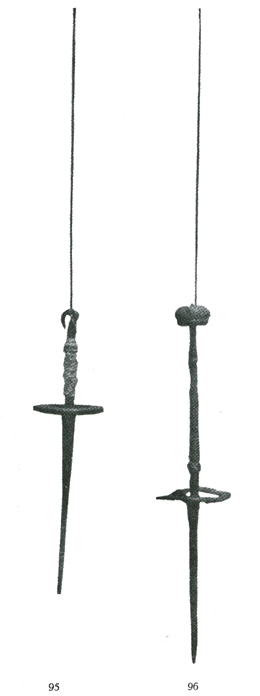Projects and Science
Romania
Europe
ABT
Wire spindle or shoemaker´s spindles from Romania
The plying spindle, which once was common everywhere, but disappeared with the appearance of the spinning wheel, has survived in Transylvania up to the present day [1910!]. It can be found both in the cities and in the countryside. It is used mainly by shoemakers, who produce the footwear for the rural population. These plying spindles and their whorls (Fig. 95) - they are called wire spindles by the shoemakers - are made of iron. Their upper ends terminate in a hook to which the yarns are attached.
A similar iron spindle that was found (together with numerous of other finds) in the course of digging a foundation in Neppendorf is now housed in the Museum of Baron Brukenthal. Based on the saex found near the spindle it can be dated to the XV. or the beginning of the XVI. century. This spindle has no hook but a peculiar clay whorl found nearby that fits exactly to it and was probably intended to fasten the yarn to the spindle tip (Fig. 96).
[this dating must be challenged today. 1. Saex were in use in Europe from about the 4th century BC to the 5th century AD. 2. Just because the spindle was found near the saex does not automatically date them to the same time period, especially since the workers have probably not made satisfactory observations during the digging as far as archaeological layers are concerned. One must also consider the age of this publication and the state of the art in 1910. - Note of the ABT]
How to use the shoemaker´s spindles
The wire spindle is used in the way that the worker, who is sitting on a stool, ties the ends of the yarn to be plied onto the spindle hook. The yarns to which the spindle is attached are held in the raised left hand so that the spindle almost touches the ground. The right hand then places the spindle with its lower end on the right thigh from where it is rubbed down with the palm of the hand to rotate freely. The finished plied part is wound onto the spindle above the whorl and the hook above this part is hung between the yarns to start anew. (translation by the ABT)
Wire spindles from Romania: 95: Iron shoemaker´s spindle from Hermannstadt (today: Sibiu); 96: Iron shoemaker´s spindle with clay whorl. Late medieval times [?] from Neppendorf (today: Turnișor, Transylvania).

From: Mauritius von Kimakowicz-Winnicki, Spinn- und Webewerkzeuge: Entwicklung und Anwendung in vorgeschichtlicher Zeit Europas. Mannus-Bibliothek 2, Verlag Curt Kabitzsch (Leipzig 1. ed. 1910 / 2. unpubl. ed. 1930), 10-13.